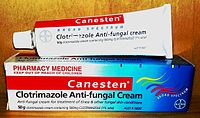
Photo from wikipedia
Undecylenic acid, a monounsaturated fatty acid, is currently in clinical use as a topical antifungal agent, however the potential for therapeutic application in other disease settings has not been investigated.… Click to show full abstract
Undecylenic acid, a monounsaturated fatty acid, is currently in clinical use as a topical antifungal agent, however the potential for therapeutic application in other disease settings has not been investigated. In this study, we describe a novel platform for the solubilization of fatty acids using amino acids and utilize this approach to define a tumoricidal activity and underlying mechanism for undecylenic acid. We examined a novel formulation of undecylenic acid compounded with L-Arginine, called GS-1, that induced concentration-dependent tumor cell death, with undecylenic acid being the cytotoxic component. Further investigation revealed that GS-1-mediated cell death was caspase-dependent with a reduction in mitochondrial membrane potential, suggesting a pro-apoptotic mechanism of action. Additionally, GS-1 was found to localize intracellularly to lipid droplets. In contrast to previous studies where lipid droplets have been shown to be protective against fatty acid-induced cell death, we showed that lipid droplets could not protect against GS-1-induced cytotoxicity. We also found a role for Fatty Acid Transport Protein 2 (FATP2) in the uptake of this compound. Collectively, this study demonstrates that GS-1 has effective pro-apoptotic antitumor activity in vitro and, together with the novel platform of fatty acid solubilization, contributes to the re-emerging field of fatty acids as potential anti-cancer therapeutics.
Journal Title: International Journal of Molecular Sciences
Year Published: 2022
Link to full text (if available)
Share on Social Media: Sign Up to like & get
recommendations!